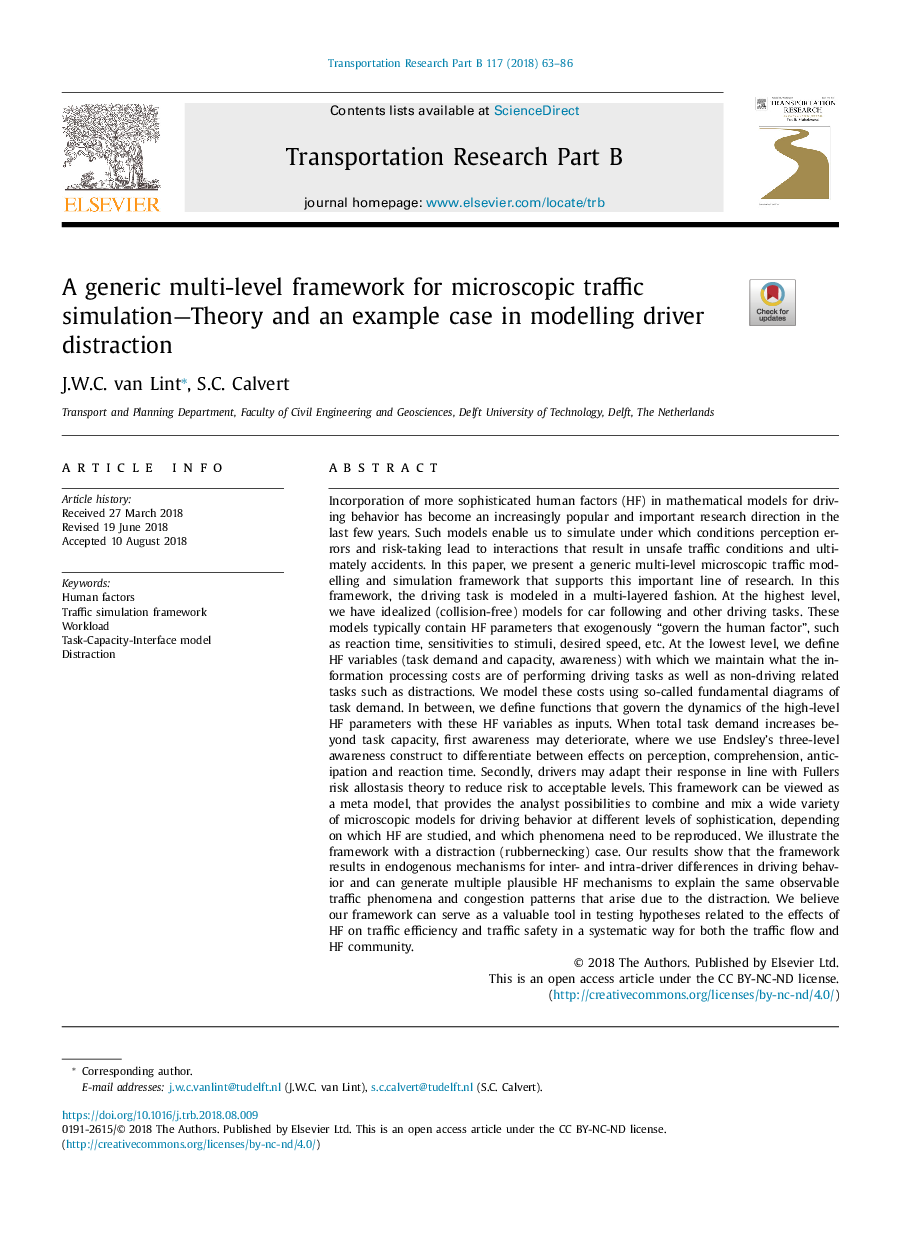| کد مقاله | کد نشریه | سال انتشار | مقاله انگلیسی | نسخه تمام متن |
|---|---|---|---|---|
| 10140693 | 1646041 | 2018 | 24 صفحه PDF | دانلود رایگان |
عنوان انگلیسی مقاله ISI
A generic multi-level framework for microscopic traffic simulation-Theory and an example case in modelling driver distraction
ترجمه فارسی عنوان
یک چارچوب چندسطحی عمومی برای شبیه سازی ترافیک میکروسکوپی-نظریه و یک مثال در مدل ریز حواس پرتی راننده
دانلود مقاله + سفارش ترجمه
دانلود مقاله ISI انگلیسی
رایگان برای ایرانیان
کلمات کلیدی
عوامل انسانی، چارچوب شبیه سازی ترافیک، حجم کار، مدل وظیفه ظرفیت-رابط، حواس پرتی،
موضوعات مرتبط
علوم انسانی و اجتماعی
علوم تصمیم گیری
علوم مدیریت و مطالعات اجرایی
چکیده انگلیسی
Incorporation of more sophisticated human factors (HF) in mathematical models for driving behavior has become an increasingly popular and important research direction in the last few years. Such models enable us to simulate under which conditions perception errors and risk-taking lead to interactions that result in unsafe traffic conditions and ultimately accidents. In this paper, we present a generic multi-level microscopic traffic modelling and simulation framework that supports this important line of research. In this framework, the driving task is modeled in a multi-layered fashion. At the highest level, we have idealized (collision-free) models for car following and other driving tasks. These models typically contain HF parameters that exogenously “govern the human factor”, such as reaction time, sensitivities to stimuli, desired speed, etc. At the lowest level, we define HF variables (task demand and capacity, awareness) with which we maintain what the information processing costs are of performing driving tasks as well as non-driving related tasks such as distractions. We model these costs using so-called fundamental diagrams of task demand. In between, we define functions that govern the dynamics of the high-level HF parameters with these HF variables as inputs. When total task demand increases beyond task capacity, first awareness may deteriorate, where we use Endsley's three-level awareness construct to differentiate between effects on perception, comprehension, anticipation and reaction time. Secondly, drivers may adapt their response in line with Fullers risk allostasis theory to reduce risk to acceptable levels. This framework can be viewed as a meta model, that provides the analyst possibilities to combine and mix a wide variety of microscopic models for driving behavior at different levels of sophistication, depending on which HF are studied, and which phenomena need to be reproduced. We illustrate the framework with a distraction (rubbernecking) case. Our results show that the framework results in endogenous mechanisms for inter- and intra-driver differences in driving behavior and can generate multiple plausible HF mechanisms to explain the same observable traffic phenomena and congestion patterns that arise due to the distraction. We believe our framework can serve as a valuable tool in testing hypotheses related to the effects of HF on traffic efficiency and traffic safety in a systematic way for both the traffic flow and HF community.
ناشر
Database: Elsevier - ScienceDirect (ساینس دایرکت)
Journal: Transportation Research Part B: Methodological - Volume 117, Part A, November 2018, Pages 63-86
Journal: Transportation Research Part B: Methodological - Volume 117, Part A, November 2018, Pages 63-86
نویسندگان
J.W.C. van Lint, S.C. Calvert,
